September 20, 2025

The article emphasizes the enhancement of therapy effectiveness in Applied Behavior Analysis (ABA) through various stimulus prompts. It explores ten distinct types of prompts:
These prompts serve to guide behavior and elevate learning outcomes. Each prompt caters to the unique needs of learners, thereby fostering an environment conducive to growth and development.
The landscape of Applied Behavior Analysis (ABA) therapy is evolving, marked by an increasing focus on the efficacy of various stimulus prompts in enhancing therapeutic outcomes. These prompts—spanning verbal and visual cues to individualized strategies—are pivotal in guiding behavior and promoting independence among learners. As the demand for tailored approaches escalates, practitioners must consider: how can they effectively implement these diverse prompting techniques to maximize engagement and learning? This article explores ten essential stimulus prompts in ABA, examining their applications, benefits, and the transformative impact they can have on therapy effectiveness.
The demand for Board Certified Behavior Analysts (BCBAs) is on the rise, with projections indicating significant growth in the field of Applied Behavior Analysis (ABA) therapy. In this competitive landscape, Hire ABA stands out as a specialized recruitment platform tailored to connect BCBAs with premier job opportunities. By streamlining the hiring process, we empower qualified professionals to seamlessly discover roles that resonate with their expertise and career goals.
Our personalized utilize advanced job fit scoring, ensuring a precise match between BCBAs and opportunities that align with their skills, preferences, and desired locations. This comprehensive support is essential in a market where the need for BCBAs continues to escalate.
Are you facing challenges in finding the right candidates? Consider how Hire ABA can transform your recruitment strategy. With our platform, you can access a pool of highly qualified professionals ready to make a difference in ABA therapy through the use of stimulus prompts aba. Take the next step in your hiring journey with Hire ABA, where we prioritize connecting talent with opportunity.
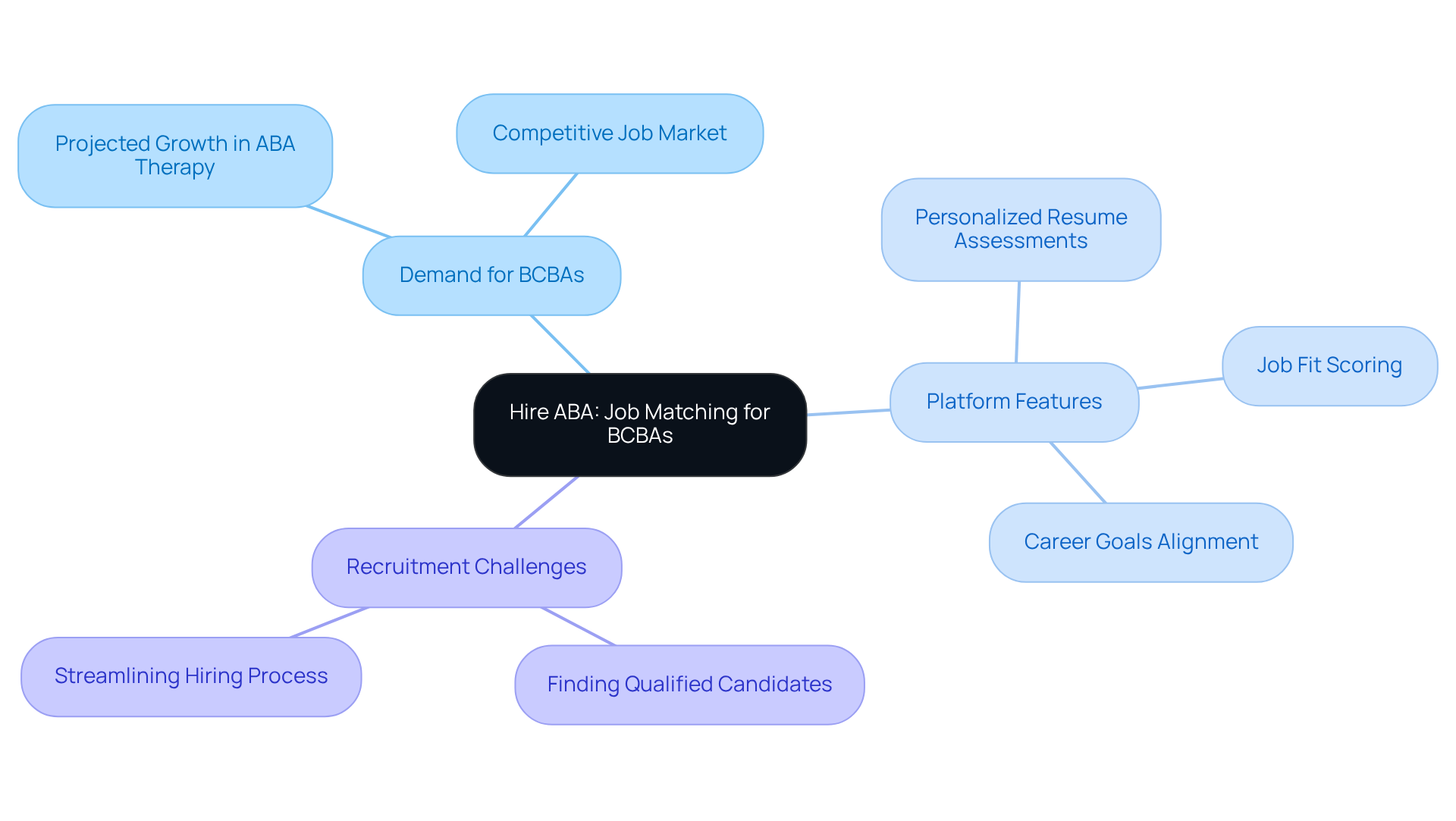
Verbal cues utilize clear and concise language to effectively guide a learner's behavior. For example, instructing a child with 'Please hand me the toy' not only directs them towards the desired action but also clarifies expectations. This method, which utilizes , is crucial in reinforcing language skills, making it an essential component of ABA therapy.
Research indicates that verbal cues, especially when combined with other methods, can achieve success rates of up to 78% in communication training programs. Moreover, children who receive consistent verbal prompting show significant improvements in expressive language development, with rates reaching up to 67%.
In therapeutic settings, the application of verbal cues has proven effective in enhancing communication abilities. Therapists often tailor their cues to meet individual needs, ensuring that learners can engage meaningfully and develop essential social skills. By fostering clear communication, verbal cues act as stimulus prompts ABA that not only aid in behavioral guidance but also enhance the overall development and autonomy of individuals within ABA therapy.
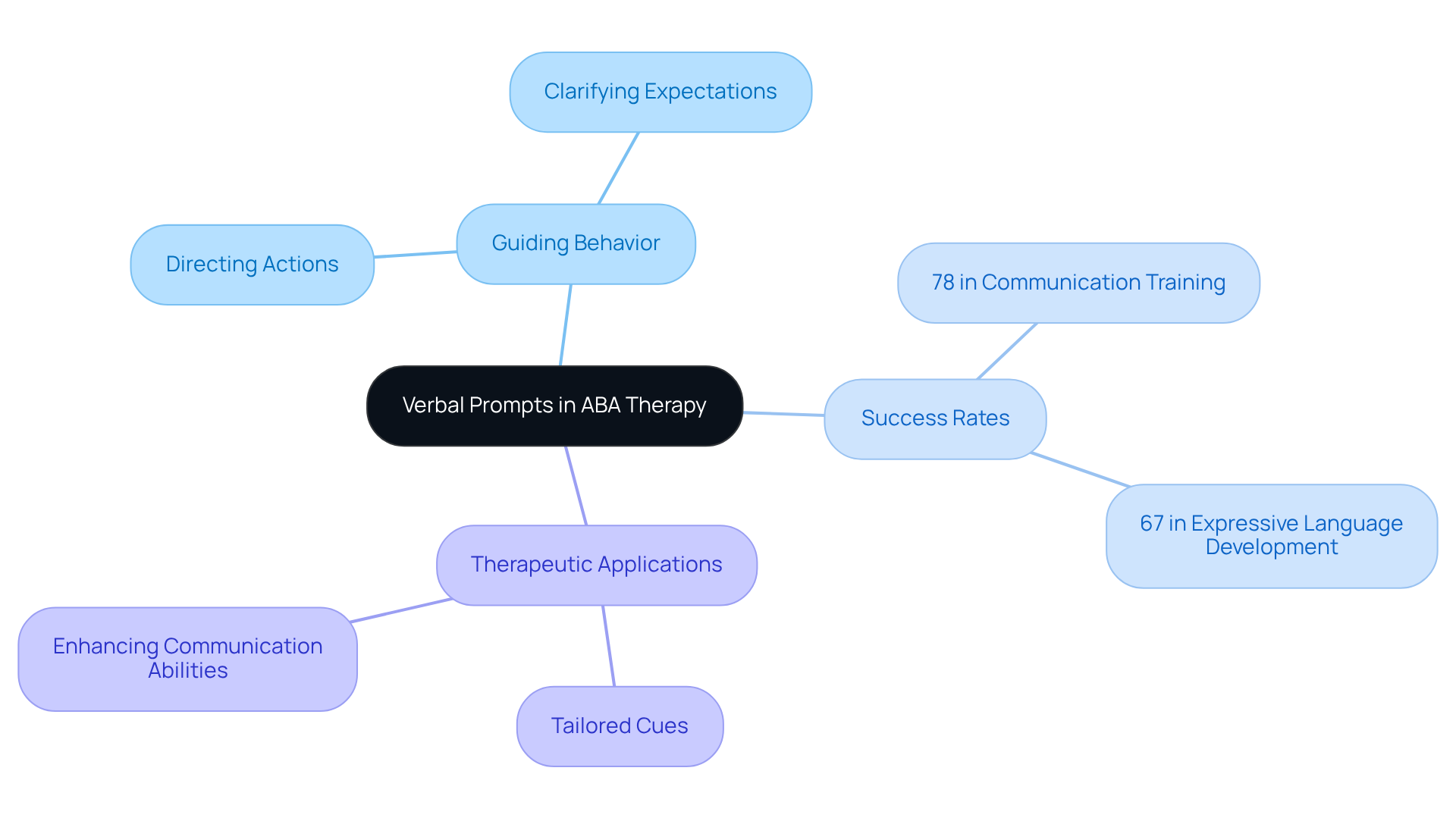
Visual cues utilize pictures, symbols, or written guidance to enhance education, particularly for individuals with autism. Various , including visual schedules, social stories, and token boards, can clarify the sequence of daily activities, making transitions smoother and more predictable.
Research indicates that visual learning preferences are prevalent among individuals on the autism spectrum, with studies demonstrating that consistent use of visual supports can lead to quicker acquisition of new skills and enhanced generalization across various settings.
Behavior analysts emphasize that visual cues not only enhance engagement but also promote independence and confidence in young individuals. As one expert noted, 'Visual supports serve as powerful tools in ABA, breaking down barriers and empowering individuals to learn, communicate, and develop social skills.'
Further insights from behavior analysts highlight that the effectiveness of visual cues in learning is reinforced by their ability to address each student's unique requirements through personalized evaluations. The impact of these visual supports is evident in case studies where young learners exhibited substantial advancements in comprehending routines and managing transitions, ultimately resulting in improved emotional regulation and social interactions.
For instance, one case study illustrated how the use of visual schedules significantly reduced anxiety during transitions, enabling children to navigate their daily activities with greater ease.
By incorporating visual cues as stimulus prompts in ABA, practitioners can establish a more effective and supportive educational atmosphere that meets the individual needs of each young person.
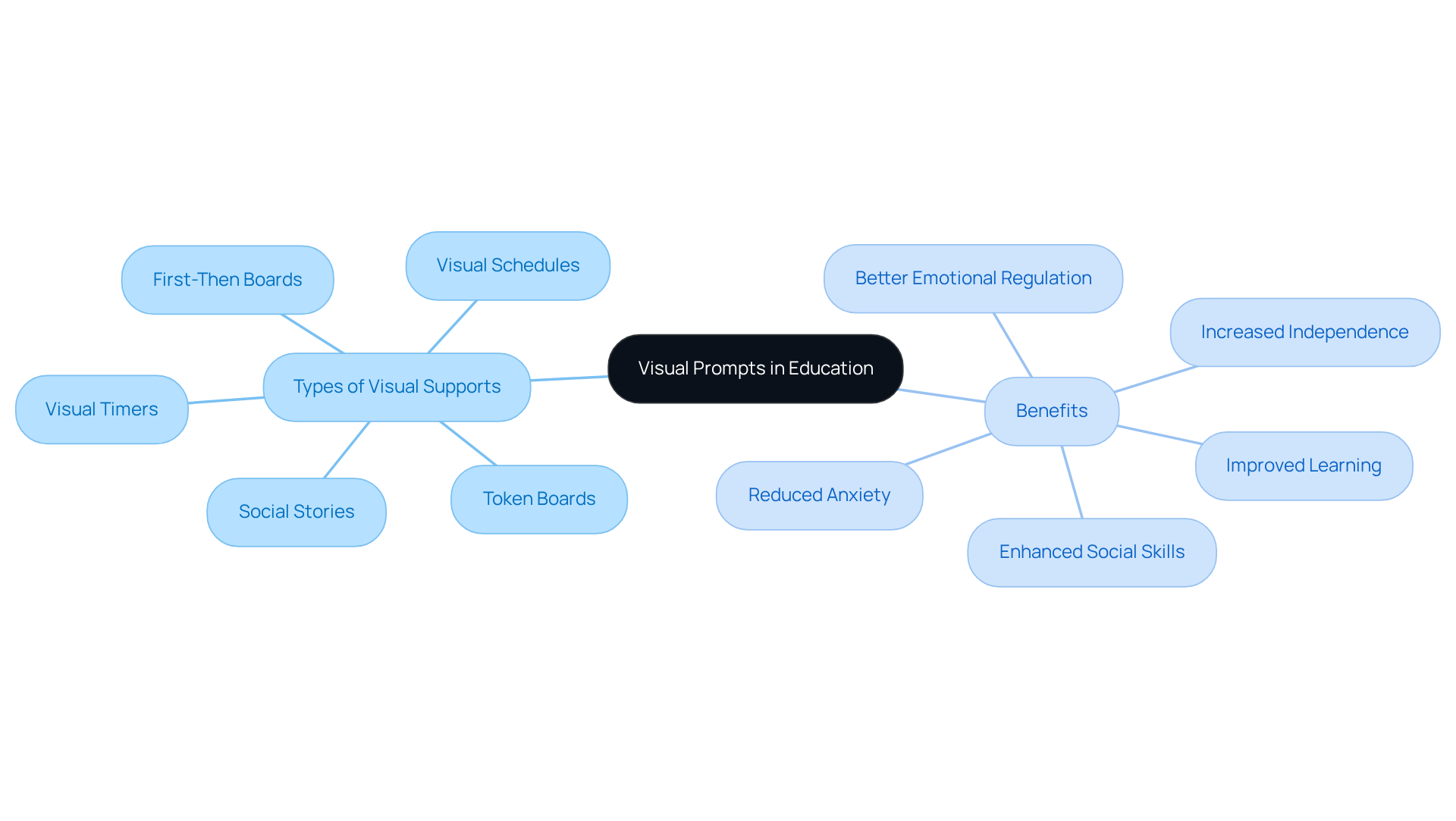
Physical cues play a critical role in guiding a student's movements through touch or hand-over-hand assistance. For example, when a child is learning to tie their shoes, a therapist might physically guide their hands through the motions. This method is particularly effective for that require motor coordination, demonstrating its value in educational settings.

Gestural prompts leverage body language and hand signals to convey messages, significantly enhancing communication for individuals, particularly those with autism. Consider this: pointing to an object can effectively direct a student's attention, leading to a clearer understanding of tasks. Research indicates that children with autism often demonstrate improved engagement and on-task behavior when non-verbal cues are utilized. In fact, studies reveal that visual activity schedules can boost task completion rates by as much as 30%.
These non-verbal communication strategies serve as important stimulus prompts aba in behavior analysis, catering to learners who may find verbal instructions challenging. By incorporating gestures as stimulus prompts aba into therapy, behavior analysts can cultivate a more intuitive learning environment. The least-to-most prompting method begins with complete physical guidance, transitioning to partial assistance and then verbal signals. This illustrates how can promote independence and self-reliance in young individuals.
Certified Behavior Analysts (BCBAs) underscore the importance of these strategies, highlighting that the consistent application of stimulus prompts aba not only enhances communication skills but also fosters social interactions. This collaborative approach empowers caregivers to actively participate in their children’s learning journeys. Consistent monitoring and teamwork between caregivers and therapists are essential for success. By employing non-verbal signals, therapists can develop tailored intervention strategies that align with each individual’s unique strengths and challenges, ensuring effective communication and skill acquisition.

Modeling prompts involve demonstrating the desired behavior for individuals to observe and imitate. For example, a therapist might illustrate how to greet someone by saying, Hello, and waving. This method employs observational education, allowing individuals to acquire new skills through imitation. Have you considered how this approach could enhance learning in your practice? By incorporating , you can foster an environment where individuals feel empowered to learn through observation, ultimately leading to improved outcomes.
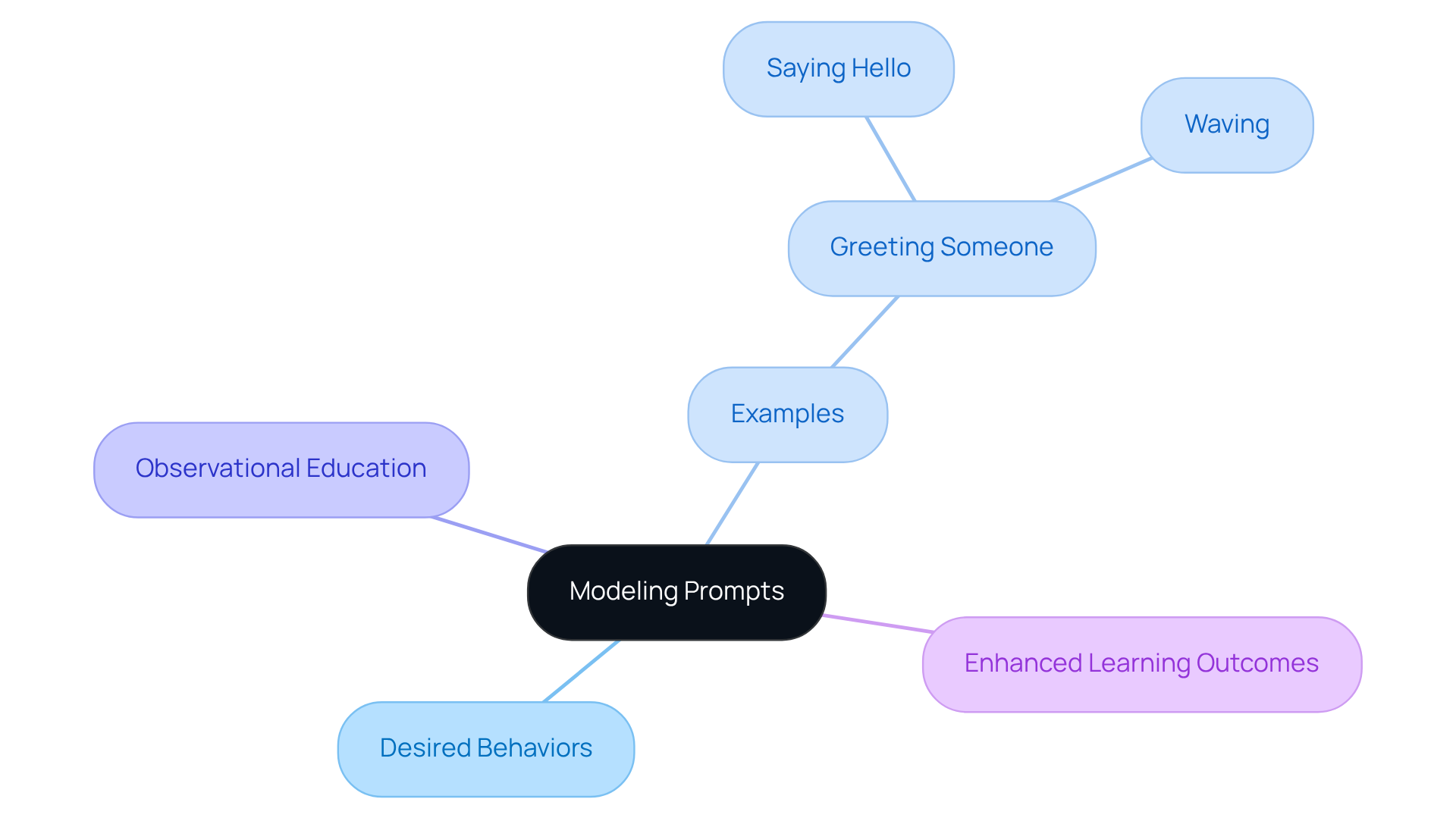
Positional prompts, which are a type of stimulus prompts in ABA, serve as a powerful tool in ABA therapy by strategically placing objects or materials to capture a learner's attention. For instance, positioning a toy within easy reach encourages a young child to interact with it, thereby promoting engagement and development. This method not only directs focus but also cultivates a supportive educational atmosphere by minimizing potential distractions. Research underscores that for individuals with autism spectrum disorder and other developmental disabilities, highlighting the necessity of tailored approaches.
Environmental factors play a crucial role in influencing children's concentration, with well-structured settings leading to enhanced engagement and improved learning outcomes. Therapists frequently emphasize the efficacy of environmental cues; when learners can easily access materials, they are more inclined to participate actively in tasks. Customizing cues not only boosts the effectiveness of ABA therapy but also fosters greater independence and confidence in the individual.
Effective environmental strategies include:
By leveraging positional cues, therapists can enhance concentration and facilitate a more efficient educational experience for individuals undergoing ABA therapy using stimulus prompts. Furthermore, understanding the hierarchy of cues—beginning with physical cues and advancing to positional cues—is essential for providing the least intrusive assistance necessary. Adjusting the level of prompting is vital to prevent dependency while ensuring effective learning.
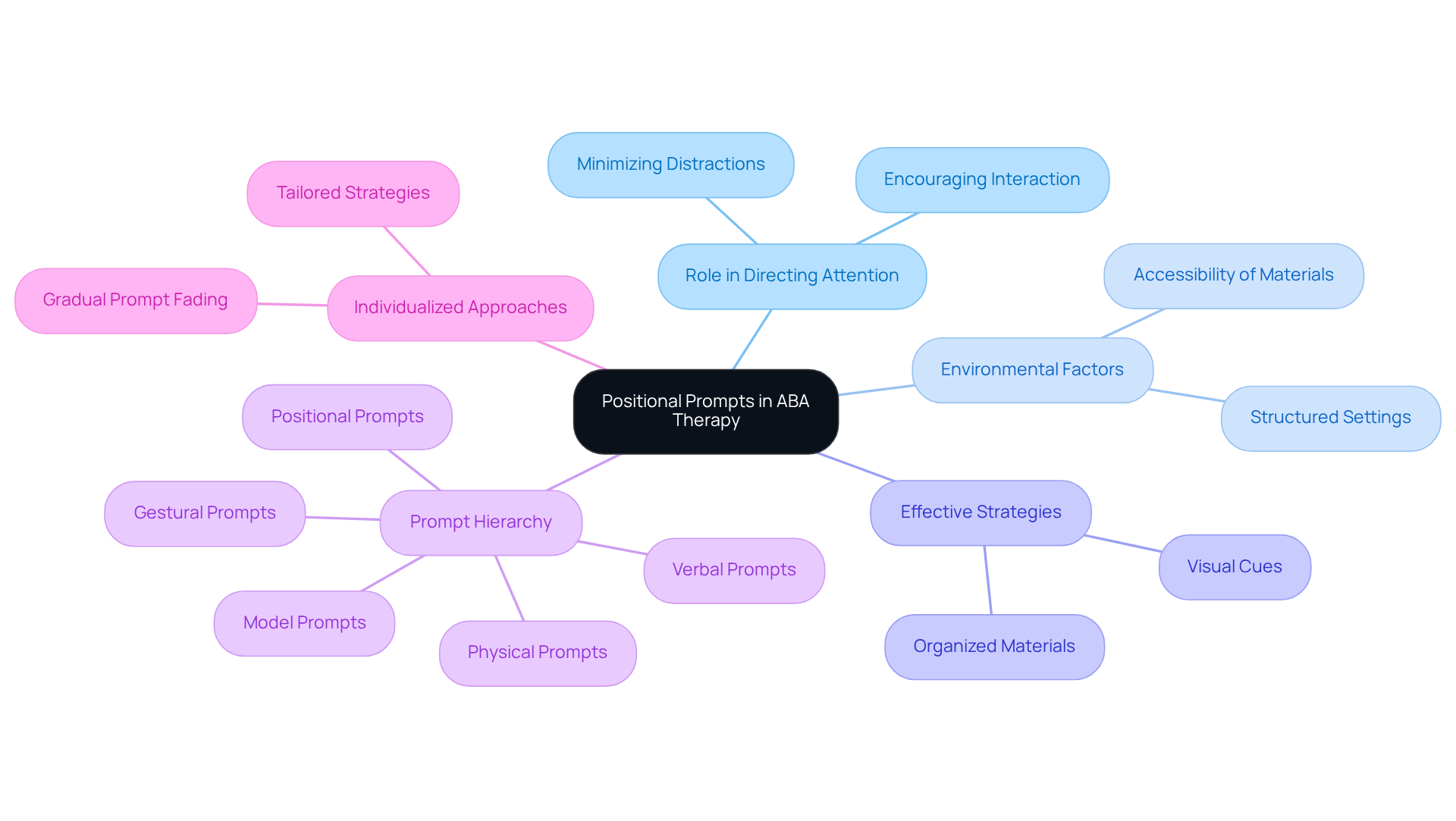
Time delay cues represent a potent technique in (ABA), utilizing stimulus prompts ABA by incorporating a brief pause before prompting a response. For instance, after posing a question, a therapist may wait three seconds before reiterating it. This approach not only fosters independent thought but also enhances individuals' capacity to formulate responses autonomously, thereby bolstering self-reliance.
Research underscores that effective fading strategies, including time delay cues, play a crucial role in nurturing independent thinking among students, with studies revealing that such techniques can diminish reliance on assistance by as much as 30%. Practical applications of this method demonstrate that individuals engaged in time delay prompting frequently display increased confidence and skill generalization across diverse environments.
Board Certified Behavior Analysts (BCBAs) highlight the significance of stimulus prompts ABA, asserting that they reinforce independent responses and deepen comprehension of the material. By implementing time delay cues, therapists can cultivate an environment that not only aids in skill acquisition but also promotes enduring autonomy in students.
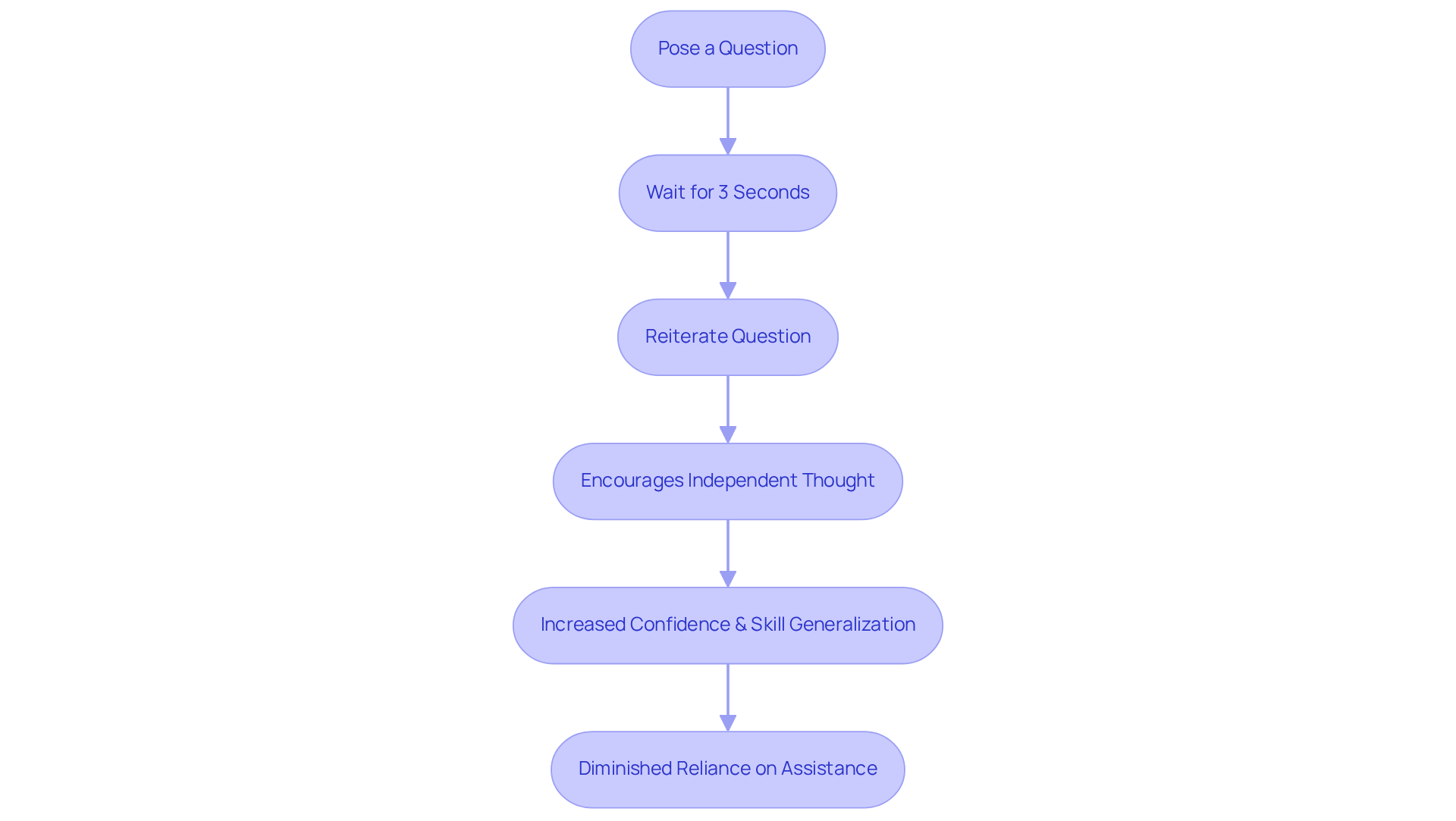
Choice prompts are a type of stimulus prompts ABA that play a crucial role in enhancing learner engagement and motivation by providing options for selection. For instance, when a child is asked, 'Would you like to play with blocks or read a book?', it empowers them within their educational journey. This strategy not only cultivates decision-making skills but also significantly improves the with the use of stimulus prompts ABA. By fostering a sense of autonomy, choice prompts encourage active participation, making learning more effective and enjoyable.
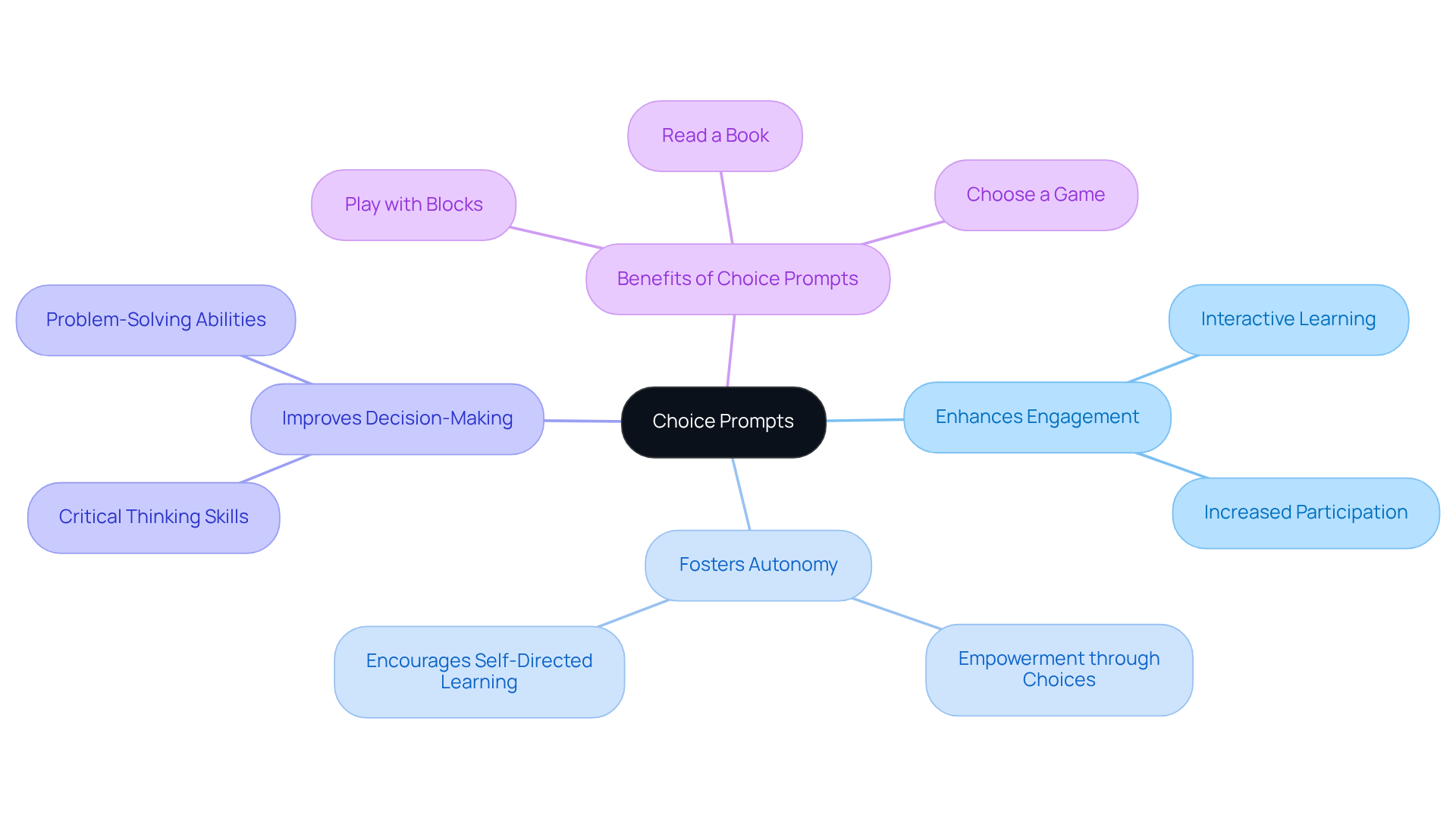
In Applied Behavior Analysis (ABA) therapy, stimulus prompts ABA are essential for providing customized cues. They involve adjusting strategies to meet the unique needs and preferences of each learner. For example, a therapist may tailor prompts based on a young person's specific interests or preferred learning style. This approach ensures that therapy remains engaging and relevant. Such personalization not only boosts engagement but also significantly improves therapeutic outcomes. Research indicates that utilizing a variety of strategies, including the 16 distinct task boxes designed for teaching social skills, leads to more effective educational experiences.
Consider real-world applications of this concept:
By customizing strategies involving stimulus prompts ABA for diverse learners, therapists create a more inclusive and effective therapeutic environment. It is crucial to adapt practices to mitigate the negative experiences that some autistic individuals have encountered with traditional ABA methods. This commitment to personalization is not just beneficial; it is vital for fostering a positive therapeutic experience.
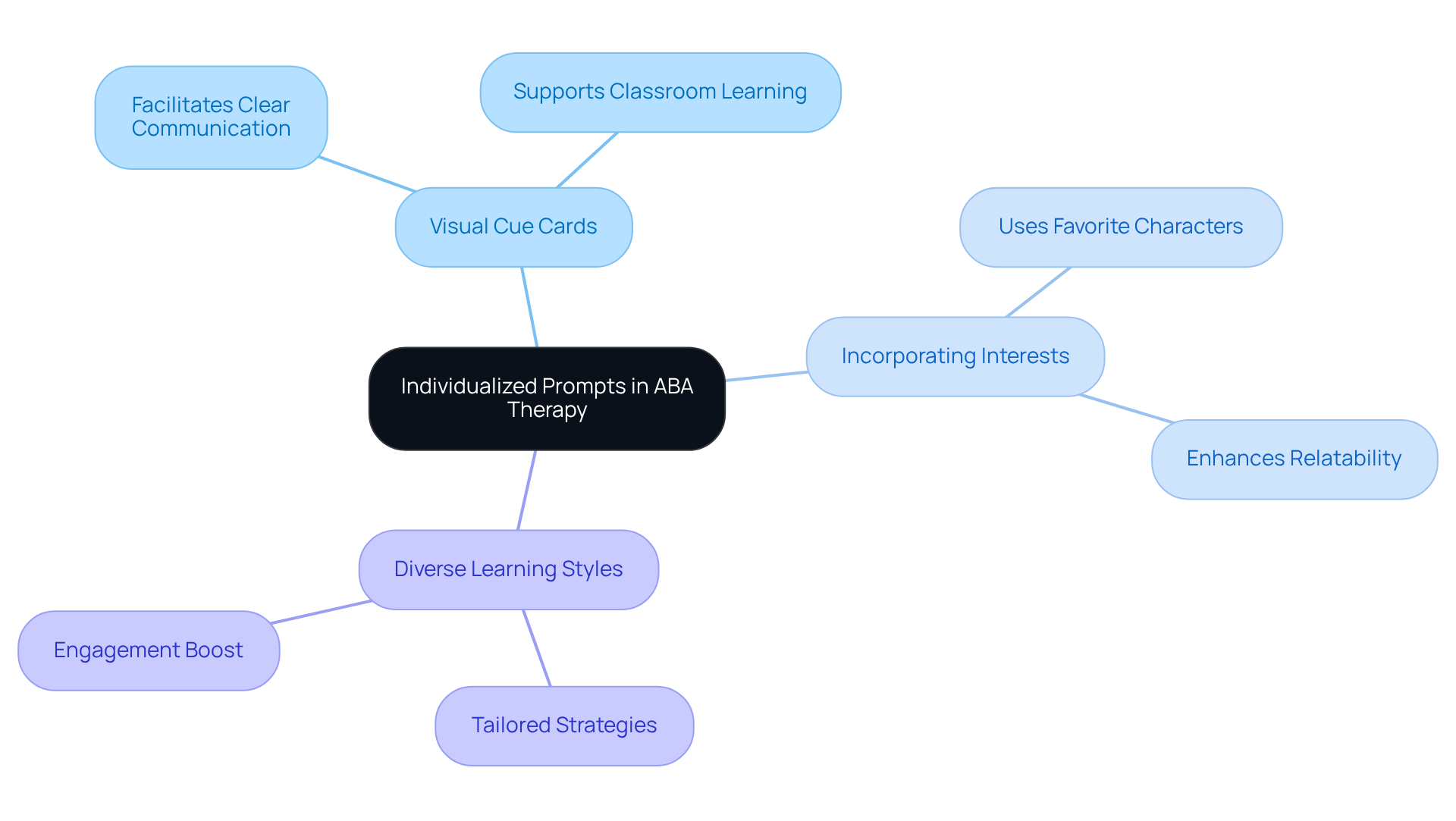
Incorporating stimulus prompts in ABA therapy is not just beneficial; it is essential for enhancing communication, engagement, and skill acquisition among learners. By utilizing a variety of prompting strategies—including verbal, visual, physical, gestural, modeling, positional, time delay, choice, and individualized prompts—therapists can tailor their approach to meet the unique needs of each individual. This customization fosters a supportive learning environment and significantly improves therapeutic outcomes.
The effectiveness of these diverse prompting techniques cannot be overstated. They play a crucial role in promoting independence, improving focus, and facilitating better communication. For instance, verbal and visual prompts have demonstrated remarkable success in enhancing expressive language skills, while choice prompts empower learners by giving them a voice in their educational journey. Each method serves as a building block in the comprehensive framework of ABA therapy, ensuring that learners remain engaged and motivated.
Ultimately, the integration of stimulus prompts in ABA therapy is a vital component in creating an inclusive and effective therapeutic experience. As the demand for skilled behavior analysts continues to rise, embracing these techniques will be crucial for fostering positive outcomes in individuals with diverse learning needs. By prioritizing personalized approaches and effective communication, practitioners can profoundly impact the lives of those they serve, paving the way for greater autonomy and success in their developmental journeys.
What is Hire ABA and how does it benefit Board Certified Behavior Analysts (BCBAs)?
Hire ABA is a specialized recruitment platform designed to connect BCBAs with job opportunities in the field of Applied Behavior Analysis (ABA) therapy. It streamlines the hiring process and provides personalized resume assessments that utilize advanced job fit scoring, ensuring a precise match between BCBAs and roles that align with their skills, preferences, and desired locations.
Why is there a growing demand for BCBAs?
The demand for BCBAs is on the rise due to significant growth projections in the field of ABA therapy. This increase in demand highlights the need for qualified professionals who can provide effective therapy and support.
How can Hire ABA assist employers in their recruitment strategy?
Hire ABA can transform recruitment strategies by providing access to a pool of highly qualified professionals ready to contribute to ABA therapy. The platform is designed to help employers find the right candidates efficiently.
What are verbal prompts and how are they used in ABA therapy?
Verbal prompts are clear and concise language cues used to guide a learner's behavior, such as instructing a child with phrases like 'Please hand me the toy.' They are essential in reinforcing language skills and enhancing communication abilities within ABA therapy.
What success rates are associated with verbal cues in communication training?
Research indicates that verbal cues, especially when combined with other methods, can achieve success rates of up to 78% in communication training programs. Children receiving consistent verbal prompting show significant improvements in expressive language development, with rates reaching up to 67%.
How do visual prompts benefit individuals with autism in the learning process?
Visual prompts, which include pictures, symbols, or written guidance, enhance education for individuals with autism by clarifying daily activities and making transitions smoother. They promote engagement, independence, and confidence, leading to quicker skill acquisition and improved social skills.
What types of visual supports are commonly used in ABA therapy?
Common visual supports in ABA therapy include visual schedules, social stories, and token boards. These tools help clarify the sequence of daily activities and assist individuals in managing transitions more effectively.
Can you provide an example of the effectiveness of visual cues in ABA therapy?
One case study demonstrated that the use of visual schedules significantly reduced anxiety during transitions for children, enabling them to navigate their daily activities with greater ease. This illustrates how visual cues can support emotional regulation and improve social interactions.
Our expert recruitment strategies and AI-driven sourcing ensure that you receive top-notch candidates quickly, without compromising on quality. Whether you’re looking for BCBAs, Clinical Directors, or RBTs, we’ve got you covered.